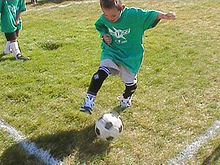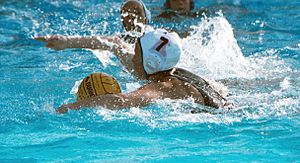Difference between revisions of "AY Honors/Basketball/Answer Key"
(No difference)
|
Revision as of 21:13, 18 May 2007
In sports such as football (soccer), basketball and water polo, dribbling refers to the maneuvering of a ball around a defender through short skillful taps or kicks with either the legs (football/soccer), hands (basketball) or swimming strokes (water polo). The purpose of such an action is to bring the ball past a defender legally and to create opportunities to score.
Association football
In association football (soccer), a dribble is one of the most difficult ball skills to master and one of the most useful attacking moves. In typical game play, players attempt to propel the ball toward their opponents' goal through individual control of the ball, such as by dribbling (running with the ball close to their feet).
The ability to dribble is often invaluable especially in the third part of a pitch or at the wings, where most attacks take place. Dribbling creates space in tight situations where the dribbler is marked (closely guarded by a defender), and the dribbler can either create scoring chances or score him- or herself after a successful dribble. However, dribbling, if poorly mastered and used, may result in the loss of possession either when the ball is intercepted or tackled by a defender.
When used appropriately, a good dribbler is often hard to dispossess; unsuccessful tackles (which do not reach the ball) may result in a useful free kick situation, a yellow card for the offender, or both.
Early references to dribbling come from accounts of medieval football games in England. For example, Geoffrey Chaucer offered an allusion to such ball skills in fourteenth century England. In the Canterbury Tales (written some time after 1380) he uses the following line: "rolleth under foot as doth a ball"[1]. Similarly at the end of the 15th century comes a Latin account of a football game with features of modern soccer which was played at Cawston, Nottinghamshire, England. It is included in a manuscript collection of the miracles of King Henry VI of England. Although the precise date is uncertain it certainly comes from between 1481 and 1500. This is the first account of an exclusively "kicking game" and the first description of dribbling: "[t]he game at which they had met for common recreation is called by some the foot-ball game. It is one in which young men, in country sport, propel a huge ball not by throwing it into the air but by striking it and rolling it along the ground, and that not with their hands but with their feet... kicking in opposite directions". It is known that dribbling skills were a key part of many nineteenth century football games at English public schools with the earliest reference to ball passing coming in 1863 rules of the English Football Association.
making the player difficult to defend and opening up options to pass, shoot or drive with the ball.
The National Association of Basketball Coaches (NABC) was founded in 1927 to oppose a move to eliminate dribbling from the sport.
Water polo
In water polo, dribbling is the technique of moving the ball while swimming forward, propelled ahead of the player with the wake created by alternating armstrokes. Since ball contact is minimal, this creates advantage for the ball carrier advancing the ball; the defender may not make contact unless the attacker is touching the ball.
See also
de:Dribbeln hr:Dribling it:Dribbling ja:ドリブル pl:Drybling ru:Дриблинг


